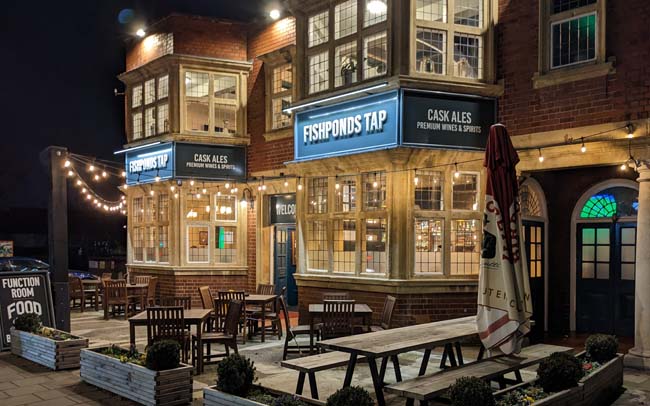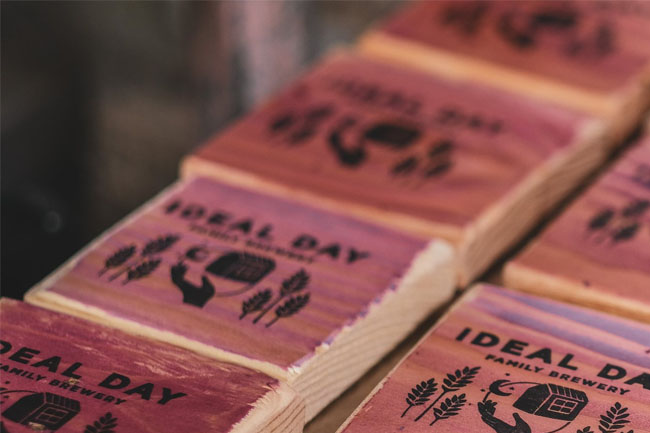Visit the Boak and Bailey's Beer Blog site
Every Saturday we compile the best reading about beer and pubs from the past week. This time we’ve got porter, pubs, and personal taste.
First, some news: Steve Dunkley is organising a Historic Brewing Conference to take place in Manchester on 5 and 6 August 2024. Speakers announced so far include Gary Gillman, Lars Marius Garshol, Laura Hadland and Pete Brown. There are also plans for a bar selling recreations of historic beers. Two-day tickets will cost £70. Follow Steve or HistoricBrewCon on your favourite social media platform to find out when they’re available.
 The Fishponds Tap in Bristol, which is listed in the book Desi Pubs.This week’s meatiest read is an academic paper called ‘A pub for England: Race and class in the time of the nation’ by Amit Singh, Sivamohan Valluvan, and James Kneale, originally published in the European Journal of Cultural Studies.
The Fishponds Tap in Bristol, which is listed in the book Desi Pubs.This week’s meatiest read is an academic paper called ‘A pub for England: Race and class in the time of the nation’ by Amit Singh, Sivamohan Valluvan, and James Kneale, originally published in the European Journal of Cultural Studies.
It was brought to our attention by David Jesudason, to whose book Desi Pubs it seems to be a response. Its 11,000 words of Academic-ese (“concomitant”, “searching conceptualisation”, and so on) are not easy to digest. But the effort is worth it.
The main argument, as we read it, is that most writing about pubs ignores the question of race altogether, shoring up the idea that pubs ‘belong’ to white working class culture. But the Desi pub points the way to a different, more inclusive, more complex idea of what pubs can be:
The UK Government’s apparent neglect of the pub has largely been represented in terms of heavy-handed and uncaring state intervention into private businesses, in the form of high and increasing levels of duty on alcoholic drinks, particularly beer; the 2007 smoking ban; and the pandemic lockdowns of 2020–2021. These characterisations of this threat evoke a particular kind of pub, one relying on income from drink rather than food, on smokers, and on the ‘regular’ patron deprived by lockdown of a ‘second home’. And as we have surveyed in the previous section, almost all such interventions, whether right or left, remain insufficiently critical of the ethnonationalist assumptions integral to these ideas of loss, or have even enthusiastically embraced them.
 SOURCE: Pellicle/Lily Waite.Last year we went to Vessel in Plymouth where proprietor Sam Congdon talked enthusiastically about Ideal Day, a farmhouse brewery just over the border in Cornwall. We made half a plan to visit, but couldn’t make it. We also made a note to find out more and maybe write something at some point. Now, for Pellicle, Lily Waite has saved us the trouble, with an in-depth profile of brewery founders Nia Rylance and James Rylance, late of Beavertown, Redchurch and Harbour:
SOURCE: Pellicle/Lily Waite.Last year we went to Vessel in Plymouth where proprietor Sam Congdon talked enthusiastically about Ideal Day, a farmhouse brewery just over the border in Cornwall. We made half a plan to visit, but couldn’t make it. We also made a note to find out more and maybe write something at some point. Now, for Pellicle, Lily Waite has saved us the trouble, with an in-depth profile of brewery founders Nia Rylance and James Rylance, late of Beavertown, Redchurch and Harbour:
Ideal Day is one of a number of businesses that make up Crocadon Farm, perched on Cornwall’s southeastern border with Devon, just north of the town of Saltash at the mouth of the Tamar Valley. A self-styled “agrotourism retreat,” Crocadon is a farm-restaurant founded by chef and farmer Dan Cox… What James is doing is, to some degree, antithetical to how he brewed toward the end of many, if not all, of his previous brewing roles. None of Ideal Day’s beers are particularly to or of a style—very deliberately so. They are, until the imminent launch of Field Beer in bottles, only available in keg, sent out individually, with a hand-finished and stamped keg badge cut down from whatever nearby tree recently fell. They taste of James and Nia’s intent, of railing very, very gently against homogeneity and mass-production.
 At Tempest in a Tankard Franz Hofer has been looking inward in an attempt to understand his own taste in beer. It’s an attempt to get closer to being objective by being transparent about his prejudices and preferences:
At Tempest in a Tankard Franz Hofer has been looking inward in an attempt to understand his own taste in beer. It’s an attempt to get closer to being objective by being transparent about his prejudices and preferences:
It’s a sunny autumn afternoon and I’ve just arrived in the Oberpfalz, home of Zoigl. I immediately become part of a tableau with Zoigl in the picture, but one that’s also much more than just about the beer. The frame around the tableau encompasses the lively squares and ornate churches, the cobblestone streets that cradle those wonderful Zoigl taverns, the meadows and rolling hills, the colour of the leaves against the sky, the fragrance of the forest as I wander from town to town in search of my next Zoigl… Does all of this cultural stuff make the beer taste “better”? It’s a question I’ve grappled with for years. But the question misses the mark. Instead, it’s more a question of remaining attentive to how these cultural frameworks – from the Wirtshaus and the beer garden to the communal brewhouse and the coolship – have shaped both the beer of a given region and my own taste in beer. Context does matter. And it’s what mitigates against our tendency to reduce beer to a mere object to be evaluated, rated, and scored.
 For Time Out Fred Garratt-Stanley has been investigating what it means for communities when the Wetherspoon closes. It’s interesting to read as on-the-ground reporting, with quotes from Wetherspoon customers, and as an analysis of the market, highlighting the rise of the Craft Union chain in particular:
For Time Out Fred Garratt-Stanley has been investigating what it means for communities when the Wetherspoon closes. It’s interesting to read as on-the-ground reporting, with quotes from Wetherspoon customers, and as an analysis of the market, highlighting the rise of the Craft Union chain in particular:
It’s true that Craft Union — an affordable pub company that has expanded significantly in recent years — appears to be benefiting from the demise of Spoons. Across the UK, the chain’s emphasis on cheap drinks, community events and a homely atmosphere for regulars has allowed them to scoop up a fair chunk of Wetherspoons’ lost trade… Despite the important role the chain plays as a meeting point for communities – particularly working-class communities – many Spoons pubs struggle to foster lasting emotional attachments with punters. The formulaic, transactional nature of the chain means that when Wetherspoons shut, it may be a blow, but locals will soon start searching for alternatives.
One of our favourite types of blog post – a staple in the early days of beer blogging – is an earnest review of a can from a corner shop. The Beer Nut, with his tendency to try any beer he encounters and judge it fairly, has sniffed out a decent Baltic porter that we’ll be looking for in our local Eastern European supermarkets:
Volfas Engelman Baltic Porter, then, is 6% ABV and the can tells us it’s in “limited supply”. Also that it’s 25 IBU, which strikes me as a little low, even if the scale is largely meaningless. Nevertheless, it pours a handsome dark brown with a modest and mangeable off-white head. The aroma gives gentle caramel and the promise of some herbal liquorice hops. Everything is in order there, then. A lager-clean texture follows, and there’s a surprise in the flavour…
Finally, from Instagram, a pub in the urban landscape on a sunny day… ah, remember sunshine?
For more good reading check out Stan Hieronymus’s round-up from Monday and Alan McLeod’s from Thursday.
News, nuggets and longreads 3 February 2024: Poker Face originally posted at Boak & Bailey's Beer Blog
More...
The Fishponds Tap in Bristol, which is listed in the book Desi Pubs.This week’s meatiest read is an academic paper called ‘A pub for England: Race and class in the time of the nation’ by Amit Singh, Sivamohan Valluvan, and James Kneale, originally published in the European Journal of Cultural Studies.
SOURCE: Pellicle/Lily Waite.Last year we went to Vessel in Plymouth where proprietor Sam Congdon talked enthusiastically about Ideal Day, a farmhouse brewery just over the border in Cornwall. We made half a plan to visit, but couldn’t make it. We also made a note to find out more and maybe write something at some point. Now, for Pellicle, Lily Waite has saved us the trouble, with an in-depth profile of brewery founders Nia Rylance and James Rylance, late of Beavertown, Redchurch and Harbour:
At Tempest in a Tankard Franz Hofer has been looking inward in an attempt to understand his own taste in beer. It’s an attempt to get closer to being objective by being transparent about his prejudices and preferences:
For Time Out Fred Garratt-Stanley has been investigating what it means for communities when the Wetherspoon closes. It’s interesting to read as on-the-ground reporting, with quotes from Wetherspoon customers, and as an analysis of the market, highlighting the rise of the Craft Union chain in particular:




 Reply With Quote
Reply With Quote